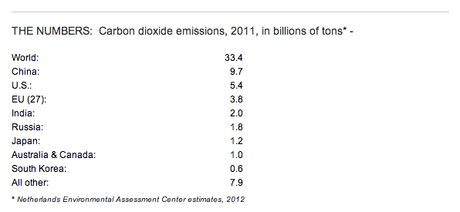-
Signed in 1998, the Kyoto Protocol asked 40 “Annex 1″ countries – the United States and Canada, western Europe, Russia and its neighbors, Japan, Australia, and New Zealand – to cut carbon emissions by 5.2 percent from the totals of 1990. The annual estimates by the Netherlands Environmental Assessment Center (NAEC) in The Hague place this 1990 total at about 15.4 billion tons. Thus the Protocol implied a cut to 14.6 billion tons.
-
“Annex 1″ country emissions rose after the Protocol signature to a peak of 15.2 billion tons in 2004. Since then they have been falling steadily.
NAEC’s estimate for 2011 is 14.36 billion tons, about 7 percent below the 1990 levels. America’s total is down from 5.9 billion to 5.4 billion tons – off by about 10 percent in the last six years, still above the 5.0 billion tons pumped out in 1990.
Explanations for the drop include (a) emissions-trading in Europe, Australia, Canada, and Japan; (b) technological advance and efficiency in manufacturing, home heating, and transport; (c) increasing use in the United States of more natural gas and other alternative fuels; (d) the temporary effects of recession and economic crisis.
Despite the cut in Annex 1 emissions, world emissions have continued to rise. In fact NAEC’s 33.9 billion-ton global estimate for 2011 is about 50 percent above the 22.4 billion-ton figure for 1990. Most emissions growth has come from China, which accounts for 8.2 billion of the 10.5 billion tons of net global emissions growth since 1990.
Bonus Fact:
World CO2 emissions rose from 25 billion tons in 2001 to 33 billion tons in 2011.

Eco-Living Magazine
Five Friday Facts: Kyoto Protocol Targets
Posted on the 26 October 2012 by 2ndgreenrevolution @2ndgreenrevAuthor's Latest Articles
-
So Erstellen Sie Bootfähige USB-Geräte Ohne Software Unter Windows 10 (mit Eingabeaufforderung)
-
Die Richtige CPU- Und GPU-Kombination Für Eine Ausgewogene Plattform?
-
Clovr Study: Media Attention Strongly Dependent on Bitcoin Course
-
Altcoin Market Analysis KW48 – Bitcoin Cash Continues to Fall, Litecoin Least Liked by Comparison

